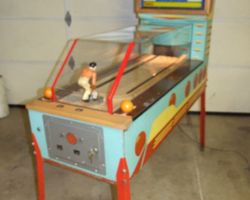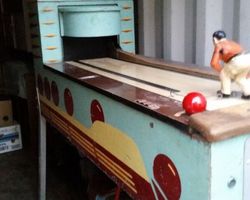Ten Strike

Average Prices: USD $1,000 to $4,000
Produced: January, 1958
Machine Type: Electro-mechanical
Players: 2
Williams Manufacturing Company, a name synonymous with innovation in the electromechanical era of arcade games, released Ten Strike in January 1958. This intriguing amusement device, designated as Model 196, was not a traditional pinball machine, despite sharing many fundamental components and design philosophies with its flipper-equipped brethren. Instead, Ten Strike carved its own niche as a sophisticated novelty bowling game, a mechanical marvel that captivated players with its intuitive controls and satisfying simulation of the sport.
The concept of a mechanical bowling game predated Williams' entry, with earlier iterations from manufacturers such as H.C. Evans and Rock-Ola. However, it was Williams that refined and perfected the design, elevating the experience with their established expertise in electromechanical engineering. Ten Strike represents the replay-enabled version of this bowling game, featuring a "match" function that allowed for continued play, in contrast to its counterpart, "Ten Pins," which operated purely as a novelty without replays. This distinction highlights Williams' understanding of arcade economics and player engagement, offering varied experiences to operators. The design and production process leveraged Williams' extensive inventory of parts, with the game utilizing the same robust cabinets, striking backglasses, and reliable scoring reels found in their popular pinball lines. This commonality in components ensured a high standard of construction quality, contributing to the machine's longevity and enduring appeal. The precise individuals responsible for Ten Strike’s design, engineering, and art are not widely documented, but the machine reflects the collective talent within Williams during a period of prolific electromechanical development.
Signature Features and Design
Ten Strike distinguished itself through a collection of features that brilliantly translated the essence of bowling into an interactive mechanical experience. At its core was the ingenuity of its control system and the physics-defying realism of its pin reset mechanism. Players manipulated a miniature bowler figure via a left-hand knob, allowing for precise aiming and strategic positioning across the lane. A separate right-hand knob triggered the release of the bowling ball, which traveled down the alley with satisfying momentum. This dual-knob control scheme offered a tactile and intuitive interface that made the act of bowling feel immediate and engaging.
The most captivating element of Ten Strike’s design was the physical action of the pins. Unlike digital simulations, Ten Strike’s pins were real, miniature objects, each meticulously positioned on a cord. When the bowling ball struck a pin, it disrupted a magnetic plane between the pin and the alley surface. This broken connection activated a mechanism that caused the weighted pin to recede and reset automatically, ready for the next frame. This intricate mechanical dance provided a tangible sense of accomplishment with every successful shot and a visual spectacle as pins reacted dynamically to impact.
Aesthetically, Ten Strike carried the distinctive visual hallmarks of Williams machines from the era. The cabinet design was robust and familiar to anyone accustomed to Williams pinball tables, providing a solid foundation for the mechanical components. The backglass art was a particularly notable feature, consistently praised for its vibrancy and thematic charm, drawing players into the game's bowling theme. Coupled with the distinct sound of two bells and a knocker, which celebrated successful shots and marked game progression, these elements coalesced to create an arcade experience that was both visually appealing and aurally gratifying. The integration of components typical of pinball machines with a completely different gameplay concept demonstrated Williams' adaptability and commitment to producing well-crafted amusement devices.
Playfield and Mechanics
The "playfield" of Ten Strike, rather than featuring traditional pinball elements like flippers or bumpers, meticulously replicated a bowling lane. The layout was straightforward yet effective, composed primarily of the long, smooth alley surface culminating in the ten bowling pins. The interactive "toys" were the bowler figure itself and the reactive pins, which were the central focus of player interaction. The design philosophy centered on direct simulation: players were not merely operating a machine but were, in essence, bowling through its mechanical extension.
The game's visual appeal extended beyond the backglass to the "alley" itself. Though not adorned with intricate artwork or flashing lights like a contemporary pinball playfield, the simplicity and realistic depiction of the bowling lane were intentional. The clean lines and straightforward presentation kept the player's focus on the critical task of aiming and rolling the ball. The lighting, while modest by modern standards, was strategically employed to illuminate the lane and highlight the pins, ensuring visibility and drawing attention to the moment of impact. This focus on clarity and functional design contributed significantly to player immersion, making the simple act of controlling the bowler and releasing the ball feel genuinely strategic. The detailed mechanism for pin resetting, involving cords and magnetic plane interruption, was an engineering achievement that added to the overall sense of a finely tuned, miniature bowling experience.
Gameplay Dynamics
Gameplay in Ten Strike revolved around precision, strategy, and the satisfying replication of a bowling match. The core objective was to knock down the ten pins at the end of the alley. Players initiated their turn by using the left knob to position the bowler figure, aiming for the perfect angle to achieve a strike or a spare. Once the aim was set, the right knob was pressed to propel the bowling ball forward. The tactile feedback from these controls, combined with the mechanical whirring and clacking of the internal mechanisms, contributed to an engaging and direct interaction.
Scoring mirrored real bowling: a strike (all ten pins down on the first ball) awarded 30 points, while a spare (all ten pins down after two balls) yielded 20 points. The game progressed through a series of frames, challenging players to optimize their shots for the highest score. While Ten Strike did not feature complex multi-ball modes or layered objectives common in later pinball machines, its depth came from the subtle nuances of its physical controls. Mastering the sensitivity of the aiming knob and the timing of the ball release was crucial for consistently hitting strikes. Players would strategize their shots, aiming for the head pin for a strike or adjusting their angle for a tricky spare conversion.
The replay feature and the two-player design of Ten Strike enhanced its appeal. Competing head-to-head against another player introduced a social and competitive dimension, making each frame a moment of shared anticipation and excitement. The "match feature," exclusive to Ten Strike, further incentivized high scores, offering additional plays for reaching certain thresholds. These elements transformed what could have been a simple amusement device into a compelling competitive experience, keeping players engaged through repeated plays. The satisfaction derived from hearing the thud of the ball against the pins, followed by the sound of the knocker signifying a strike, cemented its memorable gameplay.
Reception and Legacy
Ten Strike garnered a positive reception, maintaining its allure decades after its introduction. Its strengths, as frequently noted by enthusiasts and collectors, centered on its enduring entertainment value and its distinct mechanical engineering. The game is often described as possessing a timeless quality, offering straightforward enjoyment that transcends generational appeal. Its "old school mechanical goodness" and the evident ingenuity in its design are consistent points of appreciation. Players often highlight the quality construction typical of Williams, noting the machine’s reliability and robust build. The game evokes a sense of charm, often characterized as "whimsical" and even "magical," fostering a feeling of direct participation in the miniature bowling action. Despite its apparent simplicity, the gameplay proved to be "so simple yet so enthralling," a testament to its compelling design. Visually, Ten Strike is frequently lauded for its "clever and stunning looking" design, particularly the backglass artwork.
The primary point of clarification surrounding Ten Strike is that it is fundamentally a novelty bowling game rather than a pinball machine. While this distinction is important for accurate categorization, it does not diminish the game's merits. Instead, it highlights Williams' diverse electromechanical output and the breadth of arcade entertainment in the mid-20th century. This classification has not hampered its collectibility; indeed, mannequin arcade games, a category Ten Strike falls into, are highly sought after by collectors, partly due to their unique mechanical charm and relatively space-efficient design compared to other large arcade machines of the era.
Ten Strike's legacy is rooted in its status as a standout example of electromechanical ingenuity beyond the confines of flipper games. It showcases Williams' mastery of mechanical design and their ability to create immersive, high-quality arcade experiences using complex internal mechanisms. Its continued appeal among collectors and enthusiasts solidifies its reputation as a well-crafted, endlessly enjoyable piece of arcade history. It stands as a testament to a period when physical, intricate mechanisms defined entertainment, and the satisfaction of a perfectly executed mechanical action was the core of the player experience.
Sponsored Links
 Ebay Listings
Ebay Listings
 Auction Results
Auction Results
| Cost | Location | Date |
|---|---|---|
| USD $2,945 |  California, United States California, United States |
08 December, 2020 |
| GBP £1,200 |  United Kingdom United Kingdom |
21 February, 2015 |
| USD $5,995 |  Michigan, United States Michigan, United States |
07 March, 2012 |
| USD $2,450 |  United States United States |
03 November, 2008 |
| USD $2,550 |  North Carolina, United States North Carolina, United States |
22 April, 2008 |
| USD $195 |  United States United States |
22 July, 2007 |


Private Policy · Search Website · Contact Us
As an eBay Partner, we may earn a commission from qualifying purchases made through links on this site, at no additional cost to you.
All trademarks and copyrighted materials remain property of their respective owners. All other content copyright 2007 - 2025 Pinpedia.


